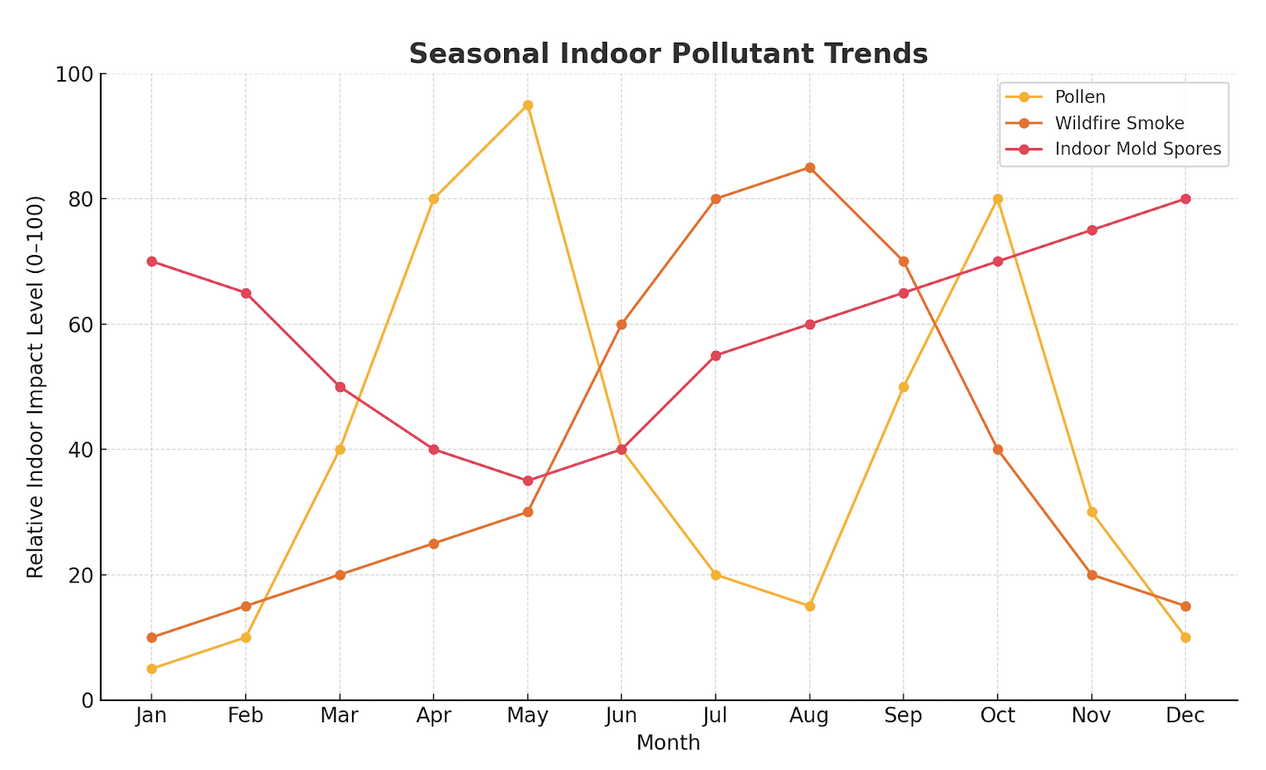Right now, the air in your home or office could be worse than a busy street corner—and you wouldn’t even know it. Seasonal temperature and humidity shifts can trap pollutants inside, creating an invisible mix of allergens, mold spores, and chemical vapors. These irritants don’t just make you uncomfortable—they can lead to lasting health issues. The good news? Catching the warning signs early can protect your lungs, your comfort, and your building itself.
The top indoor air quality red flags this month are persistent odors, visible mold, high humidity, worsening allergy symptoms, and poor ventilation. Seasonal changes can trap pollutants indoors, so indoor air quality testing and improved ventilation are essential for safe breathing.
1. Persistent or Unusual Odors
Musty, chemical, or smoky smells that linger are more than an inconvenience—they can point to mold growth, off-gassing from new building materials, or pollutants trapped indoors. Because odors are often the first sign of poor indoor air quality (IAQ), it’s important to act quickly.
Schedule an indoor air assessment before the issue spreads.
2. Visible Mold or Mildew
Even small patches of mold release airborne spores that can trigger respiratory problems, allergic reactions, and even structural damage. Seasonal humidity swings make mold growth more likely on walls, ceilings, and near windows. Addressing mold early can save you from bigger problems later—both for your health and your property.
Learn more about mold remediation.
3. High Humidity Levels and Indoor Air Quality Risks
Humidity above 60% fuels mold, dust mites, and bacteria. On the flip side, humidity below 30% can cause dry eyes, itchy skin, and irritated sinuses. A simple humidity monitor can help you stay in the ideal range of 30%–50%.
Humidity vs. Indoor Air Quality Risk
(Source: U.S. Environmental Protection Agency, “A Brief Guide to Mold, Moisture and Your Home”)
| Indoor Humidity Level | Health Impact | Air Quality Risk Level |
| < 30% | Dry skin, nosebleeds, sinus irritation | Moderate |
| 30%–50% | Ideal for comfort and health | Low |
| 50%–60% | Potential mold and dust mite growth | Moderate |
| > 60% | High mold, bacteria, and allergen growth | High |
4. Increased Allergy or Asthma Symptoms
When your symptoms spike indoors—even on low-pollen days—pollutants may be the cause. Dust, pet dander, volatile organic compounds (VOCs), and mold spores are all common indoor triggers. Seasonal ventilation patterns can trap these irritants inside, making conditions worse.
Consider professional indoor air testing to pinpoint the source.
5. Poor Ventilation or Stale Air
Without proper airflow, pollutants and allergens accumulate quickly. Blocked vents, sealed windows, or clogged HVAC filters can all be culprits. During seasonal heating or cooling, stale air can be recirculated for weeks. Replacing filters regularly and ensuring vents are clear is one of the simplest ways to boost IAQ.
Why Seasonal Changes Matter for Indoor Air Quality
During seasonal transitions, windows are closed more often and HVAC systems work harder. This traps seasonal pollutants like pollen, wildfire smoke, and vehicle emissions indoors—along with any mold spores, dust, or VOCs already present.

Indoor Air Quality Seasonal Risk Chart
(Source: Adapted from U.S. EPA Air Quality Trends Data & CDC Seasonal Allergy Data)
Figure: Seasonal Indoor Pollutant Trends – Pollen, wildfire smoke, and mold spores vary in impact throughout the year. This directly affects indoor air quality risks by season.
“Most people think of pollution as an outdoor problem, but the truth is, the air inside your home or business can be just as dangerous—sometimes worse. Seasonal changes trap contaminants indoors, and without proper testing, you may not even realize the risk until health issues appear.”
— Ed Karl, Owner, Karl Environmental
Take Action Before Red Flags Become Health Risks
Poor indoor air quality isn’t just a seasonal annoyance—it’s linked to headaches, fatigue, asthma, and long-term respiratory illness. At Karl Environmental, we help you identify hidden pollutants and create a clear, effective plan for cleaner, healthier air.
Bottom Line:
Your nose, skin, and lungs often notice IAQ problems before you consciously do—if you pay attention. Let’s make sure your air is safe before the symptoms start.
📞 Call Karl Environmental today and let’s take the first step toward fresher, cleaner air together.
Book your indoor air quality test now

